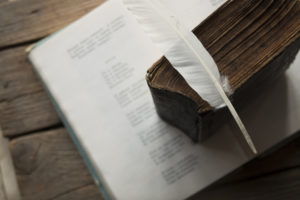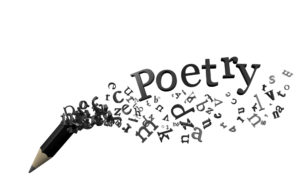Genre Spotlight: Poetry

Does the very mention of the word “poetry” take you back to high school English, tapping pentameter out on your desk, figuring out rhyme scheme and just scratching your head in confusion about how “The Red Wheelbarrow” by William Carlos Williams is even a poem?
so much depends
upon
a red wheel
barrow
glazed with rain
water
beside the white
chickens.
 Don’t worry. You’re not alone.
Don’t worry. You’re not alone.
Poetry is one of the most misunderstood genres our world has seen. It has no rules, yet somehow we all know the difference between good poetry and bad poetry. Emily Dickinson famously said this about her beloved genre, “If I feel physically as if the top of my head were taken off, I know that is poetry.”
While it may seem like there is no rhyme or reason to poetry, here are three common characteristics you’ll find in many poems.
Figurative Language
Similes, metaphors and hyperbole often find themselves in poetry, usually alongside alliteration, assonance, consonance, and rhyme. Figurative language is what leaves many people confused after reading a poem, because we have to do some work to understand it. We live in a world where we like literal meanings of things (Have you noticed the popularity of the world “literally”? It’s literally used all the time.) Figurative language, on the other hand, relies on the reader to figure out what the poet is saying. You have to use your own life experiences to draw conclusions. This is what makes poems confusing, but also what makes them universal. You may not know anything about red wheelbarrows or chickens, but what feelings come up when you read the phrase “so much depends upon…”? That phrase sets up the entire feeling of the poem and that phrase is what makes it relatable. (Side Note: If you’re writing poems and dabbling with figurative language, make sure to avoid using cliches.)
Deliberate line breaks
In A Poetry Handbook, poet Mary Oliver says, “Prose is printed (or written) within the confines of margins, while poetry is written in lines that do not necessarily pay any attention to the margins, especially the right margin.” When you write a paper for class or a report for work, you’re told very specifically what the margins should be, what the font should be, and you are told how many sentences are in a paragraph. In a poem, however, there are no rules, which leads to a very unique experience for the reader. “The Red Wheelbarrow” would read very differently if it was simply one long line. But the author broke it up so the reader, even if read quickly, has to take time to think about each line and create a picture in his or her mind.
Unique punctuation choices
If a poem is written with a lot of dashes, it reads a lot differently than a poem that is one continuous sentence with no punctuation at all. But overall, you will find that many poets do not take punctuation rules into consideration. Nobel Prize winning poet Jose Saramago famously said, ““Punctuation … is like traffic signs, too much of it distracted you from the road on which you traveled.” In “The Red Wheelbarrow” there is no punctuation, even though there very  easily could be a comma after barrow and a comma after rain. But the strategically placed line-breaks create pause, which is likely why the author thought punctuation wasn’t necessary.
easily could be a comma after barrow and a comma after rain. But the strategically placed line-breaks create pause, which is likely why the author thought punctuation wasn’t necessary.
It’s easy to over analyze poetry, but don’t let it scare you. You may not like Shakespearean sonnets and you may not ever understand the importance of the red wheelbarrow, but chances are there is a poem out there that speaks to you. The best way to enjoy poetry? Read it without trying to look for the deeper meaning.
